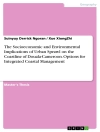Submarine mass movements represent major offshore geohazards due to their destructive and tsunami-generation potential. This potential poses a threat to human life as well as to coastal, nearshore and offshore engineering structures. Recent examples of catastrophic submarine landslide events that affected human populations (including tsunamis) are numerous; e.g., Nice airport in 1979, Papua-New Guinea in 1998, Stromboli in 2002, Finneidfjord in 1996, and the 2006 and 2009 failures in the submarine cable network around Taiwan. The Great East Japan Earthquake in March 2011 also generated submarine landslides that may have amplified effects of the devastating tsunami. Given that 30% of the World’s population live within 60 km of the coast, the hazard posed by submarine landslides is expected to grow as global sea level rises. This elevated awareness of the need for better understanding of submarine landslides is coupled with great advances in submarine mapping, sampling and monitoring technologies. Laboratory analogue and numerical modeling capabilities have also developed significantly of late. Multibeam sonar, 3D seismic reflection, and remote and autonomous underwater vehicle technologies provide hitherto unparalleled imagery of the geology beneath the oceans, permitting investigation of submarine landslide deposits in great detail. Increased and new access to drilling, coring, in situ measurements and monitoring devices allows for ground-thruth of geophysical data and provides access to samples for geotechnical laboratory experiments and information on in situ strength and effective stress conditions of underwater slopes susceptible to fail. Great advances in numerical simulation techniques of submarine landslide kinematics and tsunami propagation, particularly since the 2004 Sumatra tsunami, have also lead to increased understanding and predictability of submarine landslide consequences.
This volume consists of the latest scientificresearch by international experts in geological, geophysical, engineering and environmental aspects of submarine mass failure, focused on understanding the full spectrum of challenges presented by submarine mass movements and their consequences.
Tabela de Conteúdo
Preface.- Section I: Physical Properties of Sediments and Slope Stability Assessment.- Section II: Seafloor Geomorphology for Trigger Mechanisms and Landslide Dynamics.- Section III: Role of Fluid Flow in Slope Instability.- Section IV: Mechanics of Mass Wasting in Subduction Margins.- Section V: Post-Failure Dynamics.- Section VI: Landslide Generated Tsunamis.- Section VII: Witnessing and Quasi-Witnessing of Slope Failures.- Section VIII: Architecture of Mass Transport Deposits/Complexes.- Section IX: Relevance of Natural Climate Change in Triggering Slope Failures.- Index.












